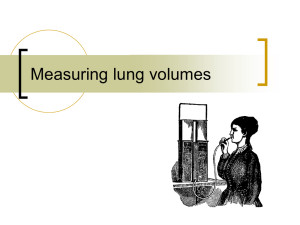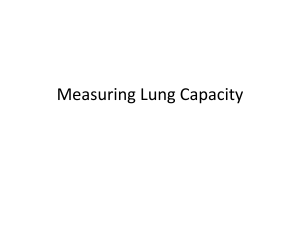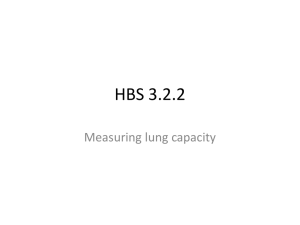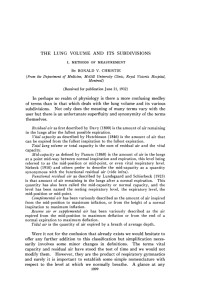Resting Lung Volumes (Spirometry) and Residual Lung Volume
advertisement
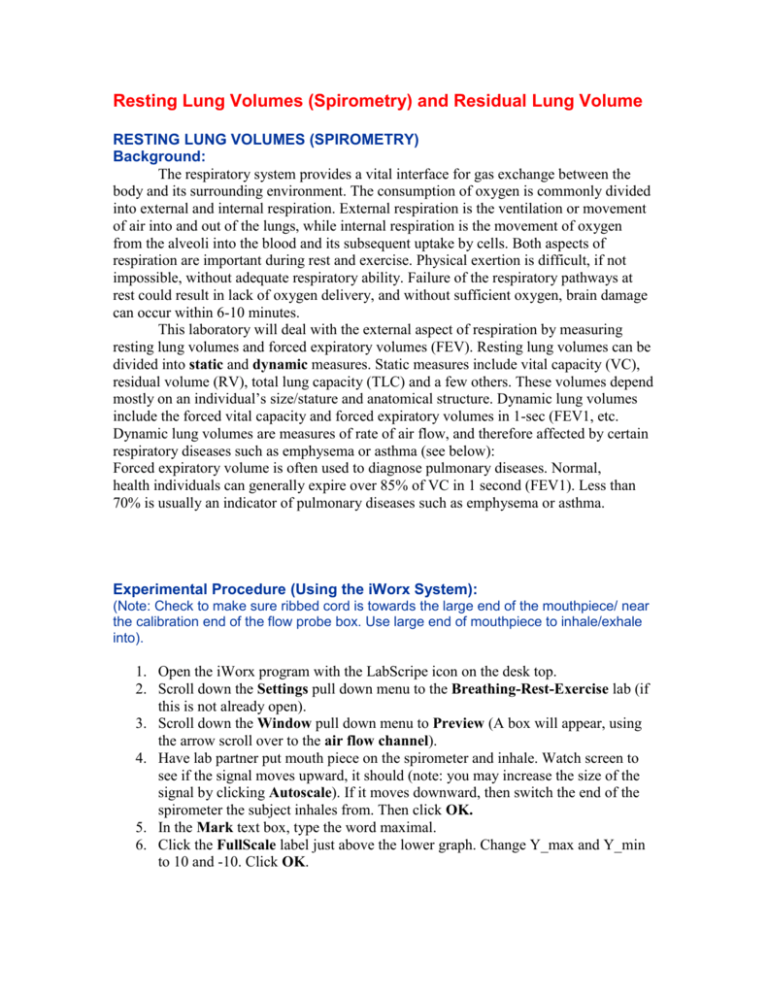
Resting Lung Volumes (Spirometry) and Residual Lung Volume RESTING LUNG VOLUMES (SPIROMETRY) Background: The respiratory system provides a vital interface for gas exchange between the body and its surrounding environment. The consumption of oxygen is commonly divided into external and internal respiration. External respiration is the ventilation or movement of air into and out of the lungs, while internal respiration is the movement of oxygen from the alveoli into the blood and its subsequent uptake by cells. Both aspects of respiration are important during rest and exercise. Physical exertion is difficult, if not impossible, without adequate respiratory ability. Failure of the respiratory pathways at rest could result in lack of oxygen delivery, and without sufficient oxygen, brain damage can occur within 6-10 minutes. This laboratory will deal with the external aspect of respiration by measuring resting lung volumes and forced expiratory volumes (FEV). Resting lung volumes can be divided into static and dynamic measures. Static measures include vital capacity (VC), residual volume (RV), total lung capacity (TLC) and a few others. These volumes depend mostly on an individual’s size/stature and anatomical structure. Dynamic lung volumes include the forced vital capacity and forced expiratory volumes in 1-sec (FEV1, etc. Dynamic lung volumes are measures of rate of air flow, and therefore affected by certain respiratory diseases such as emphysema or asthma (see below): Forced expiratory volume is often used to diagnose pulmonary diseases. Normal, health individuals can generally expire over 85% of VC in 1 second (FEV1). Less than 70% is usually an indicator of pulmonary diseases such as emphysema or asthma. Experimental Procedure (Using the iWorx System): (Note: Check to make sure ribbed cord is towards the large end of the mouthpiece/ near the calibration end of the flow probe box. Use large end of mouthpiece to inhale/exhale into). 1. Open the iWorx program with the LabScripe icon on the desk top. 2. Scroll down the Settings pull down menu to the Breathing-Rest-Exercise lab (if this is not already open). 3. Scroll down the Window pull down menu to Preview (A box will appear, using the arrow scroll over to the air flow channel). 4. Have lab partner put mouth piece on the spirometer and inhale. Watch screen to see if the signal moves upward, it should (note: you may increase the size of the signal by clicking Autoscale). If it moves downward, then switch the end of the spirometer the subject inhales from. Then click OK. 5. In the Mark text box, type the word maximal. 6. Click the FullScale label just above the lower graph. Change Y_max and Y_min to 10 and -10. Click OK. 7. Click the START button in the upper right corner of the screen. 8. When subject is ready have them apply the mouth piece, nose plug, and begin breathing through the spirometer. 9. Instruct the subject to perform 3-5 normal breaths, then a maximal inhalation (click the Mark button during this maneuver), followed immediately by a maximal exhalation. When completed hit the STOP button in the upper right corner of the screen. 10. Then click the Analysis icon on the tool bar (small blue magnifying glass icon on the left). 11. Click the 2 cursors icon on the tool bar (icon just right to the right of the double display time icon). 12. Display only the Volume (CH 5) by clicking and deselecting all other channels in the display channel list on the left side of the Analysis window. Select V2-V1 (V=volume) & T2-T1 (T=time). Note, you will need to know the time to measure the volume of FEV1.0. 13. Scroll to the beginning of the data and use the Double Display Time icon on the tool bar to fit the entire breathing cycle into your screen (icon has two little mountain peaks on it). 14. Click and drag each cursor line to points on you spirometer tracing to measure the following lung volumes: TV, IRV, ERV, VC, and FEV1.0 (remember the tracing movement upwards indicates inhaling). 15. Be sure to write down your volumes on your data sheet and the master sheet for your instructor. Data: Lung Volume Abbreviation Volume ATPS Volume BTPS Tidal Volume (TV) Vital Capacity VC (FVC) Inspiratory Reserve Volume (IRV) Expiratory Reserve Volume (ERV) Forced Expiratory Volume 1.0 (FEV1.0) RESIDUAL LUNG VOLUME The closed circuit oxygen procedure for measuring residual lung volume (RV) is commonly used in exercise physiology laboratories across the country. The advantage of this technique is its ability to test large samples in a relatively short amount of time. It does however tend to underestimate residual lung volume by about six percent and is designed to test only young (under 40 years of age) healthy adults. RV is defined as the amount of air that is left in the lungs after a maximal exhalation. Residual volume plays an important role in the exchange of metabolic gases and is also a critical value used in the determination of body density by hydrostatic weighing. The average RV for college aged males is 1300 +/- 340 ml. For college aged females the average is 1000 +/- 260 ml. RV can be correlated to the height and age of an individual. As height increases RV increases due to an increase in the size of the thoracic cavity and lungs. RV also increases with age due initially to the growth of the individual, yet continues to increase with age due to a decrease in the muscular ability to forcefully exhale air from the lungs. Exercise can also affect RV; Aerobic exercise done immediately (up to 2 hours) before testing will cause the RV to be higher, since muscles that aid in expiration can be fatigued and any fluid that may have accumulated in the lungs will make the expiration more difficult. The effect of short term, aerobic training (2 to 10 weeks) can cause the RV to decrease due to a strengthening effect on the respiratory muscles. Long term training (> 1 year) will tend to cause the RV to increase as the body adapts to more a efficient method of gas exchange. The closed circuit oxygen system for determining residual lung volume is based on the nitrogen dilution principle. The two main gases of concern are oxygen (02) and nitrogen (N2). The N2 content of alveolar air can be measured at any point by a nitrogen analyzer. The initial nitrogen content of alveolar air is measured during a maximal expiration. In order to determine the volume of air still left in the lungs after that point, it is necessary for the subject to breath only pure oxygen. Over the course of a few breaths (7-10 deep breaths) the nitrogen left in the lungs completely mixes with the oxygen and thus the combination of these two gases is the mixture being breathed. At this point a nitrogen analyzer will read an equilibrium nitrogen content. Some nitrogen may still be left in the lungs, so a subsequent maximal expiration is needed to measure the final nitrogen content of the alveolar air. Using this data, RV can be calculated. RV Procedure: 1. Subject will need a disposable mouth piece and a nose plug. 2. Experimenter will fill the spirometer bell with 100% O2 to approximately 5.0-6.0 Liters (you may sample this gas to check that the mixture of gas has reached 100% O2, Lab instructor will assist with this). 3. When 100% O2 has been reach in the spirometer bell the subject may attach the mouth piece and apply his/her nose piece. 4. Experimenter should turn the two-way breathing valve to room (ambient) air. 5. Subject may apply their mouth to the mouth piece and begin to breathe room air. 6. When subject is ready, the experimenter should instruct the subject to exhale to their residual volume (exhale as much air out of their lungs as possible). 7. When the subject has reached this point, they should signal to the experimenter with a “Thumbs Up.” 8. At this point the experimenter should turn the two-way valve so that the subject is breathing into the spirometer bell (100% O2). 9. The experimenter should instruct the subject to take 7 breaths that last approx. 2 sec. ea. 10. After the last breath the subject should be instructed to exhale again to residual volume. Directly after this the experimenter should switch the valve one more time to lock the bell in the position. 11. Check the bell to see if the volume of air in the bell is the same as when you started this procedure. If it is not, the subject may have not exhaled all their air originally, after the procedure, or there may be a leak in the spirometer. 12. Your lab instructor will then help attach the CO2 & O2 analyzers to the spirometer bell so you may read the percentages of CO2 & O2 within the spirometer bell (allow the analyzers to sample for at least :45s). 13. Remember to flush the spirometer before testing another subject or measuring a second trial. Data: PBar ______________ TA _______________ Spirometer Dead Space________ Subject V initial Equilibrium FCO2 Equilibrium FO2 Residual Volume Analysis Nitrogen is a metabolically inert gas meaning that it is neither produced nor consumed in the body. Therefore the amount of nitrogen in the closed system of the lung plus spirometer is the same at the beginning of the test as it is at the end. At the beginning of the test the percent of nitrogen in the lungs is the same as in air in the environment (79.04%), and the percent of nitrogen in the spirometer can be read from the mass spectrometer on the computer screen (call the decimal form of this Initial N2). At the end of the test, these two volumes have been mixed and so the percent of nitrogen in the lungs is the same of that in the spirometer which can be read off of the computer screen (call the decimal form of this Equilibrium N2). So the amount of nitrogen in the system at the beginning of the test is (RV x 0.7904) + (SV x Initial N2) Where RV = residual volume and SV = spirometer volume (including spirometer dead space). At the end of the test, the amount of nitrogen in the system is (RV + SV) x Equilibrium N2 Because nitrogen is metabolically inert, the amount of nitrogen in the system doesn’t change and these two values can be set equal.
